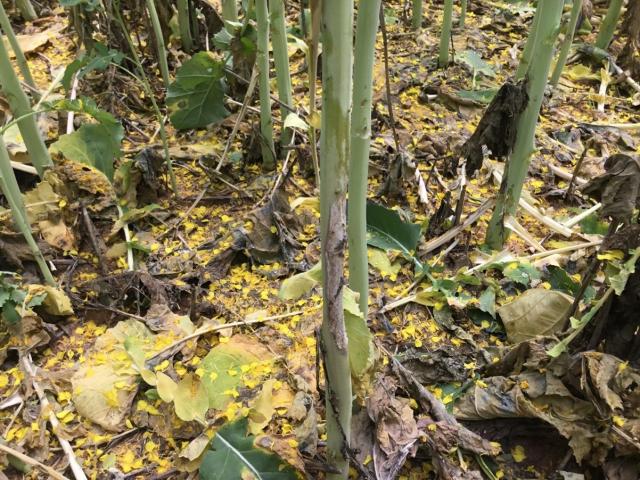In this issue of Protecting WA Crops we cover plant pathology topics that were presented by Department of Primary Industries and Regional Development (DPIRD) staff for the 2024 Grains Research and Development Corporation (GRDC) Perth Research Updates, held in February.
Sclerotinia in Canola update: Current Understanding, Emerging Opportunities, and Knowledge Gaps
At a glance:
- As Sclerotinia disease in canola is often unpredictable and sporadic with high variability between regions and years, researching the disease and how to effectively manage it can be challenging.
- The SclerotiniaCM decision support tool, and the research underpinning it, can reduce unnecessary fungicide applications and improve grower’s profitability.
- A new method for rapid, low-cost and consistent screening of canola varieties for Sclerotinia disease resistance has been developed. This method has the potential to reduce the dependency on unpredictable field testing.
Sclerotinia stem rot (SSR), caused by the fungus Sclerotinia sclerotiorum, can cause significant yield loss in canola when environmental conditions are favourable. Sclerotia, the fruiting bodies of the fungus that look like rat droppings, can survive for several years in the soil, infecting subsequent broadleaf crops. Where paddocks have had lupin or canola grown in the previous six years, growers should assume there is a Sclerotinia risk.
Sclerotinia stem rot is a difficult disease to manage due to its unpredictability and lack of Australian varieties with resistance to the disease. Research into SSR has been conducted over the past decade by DPIRD, Centre for Crop and Disease Management (CCDM) and other research collaborators to learn more about this problematic disease. A summary of what has been learnt from this research was presented at the GRDC Perth Research Updates.
Research in WA, in both the field and lab, has found that sclerotia can survive for at least six growing seasons on the soil surface and that hot, dry summer conditions are required to condition them for germination. It was also discovered that the temperature requirements for pre-conditioning and germination of sclerotia varied across the grainbelt as they had adapted to the local environmental conditions where they had formed.
Further to this, since 2010, ongoing field trials have found that the risk of crop infection is heavily dependent on various factors, including weather conditions such as season break, temperature, moisture, and humidity, as well as crop and paddock conditions such as infection history, soil type, crop density and time of flowering. The range of factors influencing SSR makes disease occurrence highly variable and management difficult.
Regular rainfall and high humidity (>75%) in the three weeks before and after commencement of flowering are most conducive for damaging levels of canopy Sclerotinia to occur in crops. Temperatures between 15-25°C favours disease development so seasons or regions with cold winters may constrain crop symptoms until spring.
Sclerotinia management options
Research into management options has found that rotating with non-host crops and applying a registered foliar fungicide during crop flowering, if disease risk is considered high, are currently the best management strategies.
Fungicide applications can reduce canopy infections of SSR, but the timing of the application is very important, and research has found that it’s not always economical. Out of 90 trials conducted by DPIRD and CCDM between 2010-2013, less than a quarter showed a yield gain following a foliar fungicide application during flowering. However, in areas of high frequencies of Sclerotinia infection, a foliar fungicide application between 20-50% bloom could be an effective strategy if conditions are conducive to infection. A second fungicide application at 50% bloom is generally only useful in seasons when the flowering period is prolonged due to extended wet conditions, and when the first spray was applied early. Fungicides should not be applied after 50% bloom.
The use of the SclerotiniaCM App, developed by DPIRD in collaboration with national canola pathologists, has been demonstrated in on-farm trials and by industry uptake to be a useful tool for determining the likely yield impact and economic returns from applying fungicide for Sclerotinia stem rot management at specific times during flowering.
A new method for future screening of canola lines for Sclerotinia stem rot resistance.
A new high-throughput method that leads to reliable and consistent Sclerotinia infection has been developed by CCDM. This technique will allow canola breeders to effectively screen new canola lines for Sclerotinia disease resistance faster and more reliably than before, without having to rely on conducive environmental conditions for disease development.
This research was funded by GRDC and supported by WA canola growers who hosted trials.
For more information refer to GRDC Research Updates paper Sclerotinia in Canola update: Current Understanding, Emerging Opportunities, and Knowledge Gaps and DPIRD webpages Managing Sclerotinia stem rot in canola and SclerotiniaCM -Sclerotinia management app.

